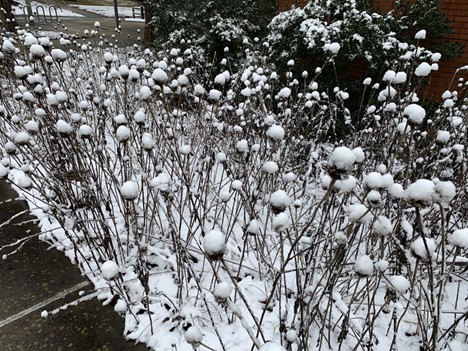Field Notes
with Raleigh Horticulturist, Neal Wisenbaker

What is there in the winter landscape if one doesn’t have evergreen plants, asks the inexperienced gardener.
As we progress towards the end of the year the winter landscape conjures up images of death, dying, and things devoid of color and life. There’s a world of beauty and life found in the remains of plants at the end of the year. I don’t recall the source, but I read once that things are beautiful because they die. And it’s not really some end-of-the-world scenario, because we know that spring, with its youthful verdant sprouting, is just around the corner. However, we must embrace and appreciate the cycle of fall and winter for now. The garden is a four-season enterprise. There is not a season that doesn’t deliver – if only we’re willing to see.
 In Noël Kingsbury’s excellent book, Seedheads in the Garden, he fully embraces the winter garden by appreciating the seedheads of perennial plants in their winter form. If one looks, they may appreciate the umbrella lace-like skeleton of yarrow placed precariously against a golden glow of dry switchgrass. Or a dusting of hoar frost on black-eyed Susan causing an odd gray color that plants just aren’t supposed to be. Or the mysterious and somewhat humorous snow caps on echinacea all lined up like processioners.
In Noël Kingsbury’s excellent book, Seedheads in the Garden, he fully embraces the winter garden by appreciating the seedheads of perennial plants in their winter form. If one looks, they may appreciate the umbrella lace-like skeleton of yarrow placed precariously against a golden glow of dry switchgrass. Or a dusting of hoar frost on black-eyed Susan causing an odd gray color that plants just aren’t supposed to be. Or the mysterious and somewhat humorous snow caps on echinacea all lined up like processioners.
The gardener who appreciates the mysterious winter landscape must plan and act now. Dry seedheads of echinacea and black-eyed Susan should be spared from the garden shear. Leaving brown stems up now provides winter food and shelter for wildlife, winter interest, and a seed source for spring. Plan to cut back switchgrasses and other ornamental grasses in early spring instead of fall. Leave 18 inches of hollow stems to provide shelter for pollinators like cavity nesting bees and butterflies. Dry leaves and sticks provide critical habitat for a diversity of beneficial insects, pollinators, and songbirds, but require us to rethink our garden aesthetic. A more diverse and natural winter landscape is considered messy by most but hidden within is a whispered secret of life to come.
Visit the Xerces Society at www.xerces.org for more information on nesting and overwintering habitat in the garden.
